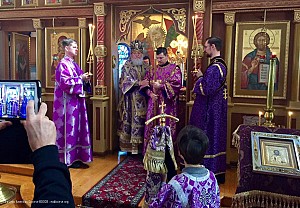
For many years I felt slightly whiplashed by this First Sunday of Great Lent. For a week we’ve been in the the Lenten Fast with its liturgical color: a sombre violet. Then suddenly and seemingly out of context, on this First of Sunday of Lent here comes the gold for the “Sunday of Orthodoxy” and our celebration of the Restoration of the Holy Icons.

It took me about thirty years to see how it all fits together – likely not by the plan of the ancient Orthodox liturgists who seemed to delight in piling different themes on top of each other. No, the Holy Spirit did it again!
Let’s begin with:
The First Sunday of Lent
Lent in the early Church was the time of preparation for catechumens who would be baptized at Pascha.
Most Lenten Sunday Epistles and Gospels were appointed to teach catechumens who Jesus Christ is, so there would be no confusion in their minds as to the identity of this God-Man to whom they were about to commit themselves.
This Sunday’s Gospel Reading (John 1:43-51) takes place early in Jesus’ ministry. He had been baptized, then tempted forty days in the desert. Now He had gone home, north to Galilee, and was calling disciples: Andrew, his brother Peter, then James and John – all fishermen.
Today Philip finds Nathanael * and cries excitedly” “We have found the Messiah, Jesus of Nazareth”. Nathanael responded: “Can anything good come out of Nazareth?” Now, I know some interpret this passage very solemnly. For myself I have always found it humorous – albeit still profound.
- almost certainly the same as the Apostle Bartholomew. Men often had both Greek and Hebrew names.
Nazareth was a village * up in the hills. Nobody important had ever come from there. There were no prophecies that the Messiah would come from Nazareth. Nathanael might have answered in a mannerly tone: “Really? Tell me more.” Instead he said, in a kind of smug, pseudo-sophisticated way: “Can anything good come out of Nazareth?” Philip responded simply “Come and see”.
- Today the population is over 75,000!
Jesus saw Nathanael coming: “Behold, an Israelite indeed, in whom there is no guile!” No pretense here! Read this as you will, but I think the Lord was poking fun at him: “no pretense” indeed! But Nathanael took him seriously: “How do you know me”? – and my sterling character. So Jesus threw another one at him: “Before Philip called you, I saw you under the fig tree.”
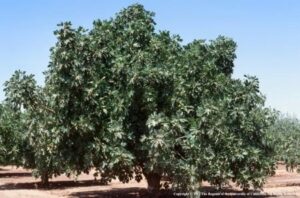
This startled Nathanael. Why? because in that region fig trees were big, had low hanging branches, so in the midday heat you could go inside to cool off. Nobody could see in there. “How ever could He have seen me under the fig tree?”
Now, we may be missing parts of the conversation here. As Saint John pointed out, all the books in the world could not contain everything Jesus did and said. No matter, at the end Nathanael cried: “Rabbi, Teacher, You are the Son of God, You are the King of Israel!” I wonder if perhaps Jesus thought to Himself: “That’s all it took? You were an easy catch! Nathanael, now you are indeed without guile.”
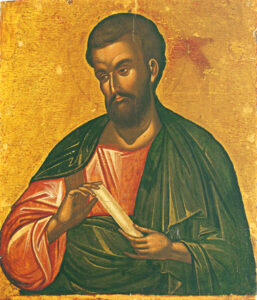
Then aloud: “You believe because I saw you under the fig tree? You will see greater things than that. You will see Heaven opened and the angels of God ascending and descending on the Son of Man”. And so he did. Jesus took this once-shallow man Nathanael and showed him the Crucifixion and the Resurrection and the Ascension, and turned him into the faithful Apostle Bartholomew who spent the rest of his life carrying the Gospel of His Lord Jesus Christ – to Arabia, maybe as far as India, then back to Persia and finally to Armenia where tradition says he was crucified and died – all for this Man who “came out of Nazareth”.
I just love that story. I couldn’t resist going through it again. But remember that these readings were intended to teach catechumens who Jesus is. And I think what the Fathers were really going after in this Gospel today are all the titles of Jesus therein. Catechumens, listen carefully: Who is this Man Jesus of Nazareth?
1) He is the Son of God, of the same essence as God the Father.
2) He is the King of Israel, the Messiah whom Moses and the prophets had foretold.
 3) He is Jacob’s Ladder, the one upon whom angels of God ascend and descend. Remember: the patriarch Jacob in a dream had beheld a ladder set up on the earth, the top of it reached to Heaven, and behold angels of God were ascending and descending on it. And when Jacob woke from sleep he thought “Surely the Lord is in this place, and I did not know it.” He was afraid and said: “How awesome is this place, this is the dwelling place of God; this is the gate of Heaven.” Genesis 28 Jesus is the ladder uniting Heaven and earth. The Lord God is in this place, in this Man, Jesus of Nazareth. He is the Gate of Heaven.
3) He is Jacob’s Ladder, the one upon whom angels of God ascend and descend. Remember: the patriarch Jacob in a dream had beheld a ladder set up on the earth, the top of it reached to Heaven, and behold angels of God were ascending and descending on it. And when Jacob woke from sleep he thought “Surely the Lord is in this place, and I did not know it.” He was afraid and said: “How awesome is this place, this is the dwelling place of God; this is the gate of Heaven.” Genesis 28 Jesus is the ladder uniting Heaven and earth. The Lord God is in this place, in this Man, Jesus of Nazareth. He is the Gate of Heaven.
4) He is the Son of Man, which means He is human, but it also means a whole lot more than that. In chapter 7 of the book of the Prophet Daniel, Daniel saw a vision of heaven, of God the Father in glory – he calls him the “Ancient of Days” – “His throne flaming with fire,.a river of fire flowing out from before Him. Thousands upon thousands attended Him; ten thousand times ten thousand stood before Him. And “then… I looked and saw one like a Son of Man, coming with the clouds of heaven. He came to the Ancient of Days and was led into His presence. To Him was given authority, glory and power; all peoples, nations and men of every language worshiped Him. His dominion is an everlasting dominion that will not pass away, His kingdom is one that will never be destroyed.” That is what “Son of Man” means. That is who Jesus is. The Archangel Gabriel repeated these words to the Virgin Mary, and we recite them again in the Creed: “His kingdom shall never end.” Early on Holy Friday morning Jesus was on trial and the high priest asked him, “Are you the Christ, the Son of the Blessed?” For the first time Jesus said, “I am, and you will see the Son of Man seated at the right hand of Power, and coming with the clouds of heaven.” Matthew 14:61-62
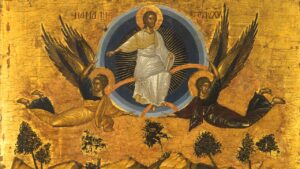
Listen, you catechumens, Christianity is no ordinary religion. Jesus is no ordinary man. He is unique. He the Alpha and the Omega, the Beginning and the End of all things. His Kingdom is forever. In Him is the key to all things, in Heaven and on earth, in life and death and what comes after death. Jesus of Nazareth is the one true God made Man.
And that leads us right back to:
The Sunday of Orthodoxy.
For over a hundred years in the Eighth and Ninth Centuries the Iconoclastic Controversy had raged, on and off and on again. Murals had been whitewashed over, countless icons destroyed. Most ancient iconography was lost.
What was this all about?
1 The issue was not art, not pictures. I mean, who would die or be imprisoned for decades to protect even the Mona Lisa?

2 Strangely enough the Iconoclastic emperors, beginning with Leo the Isaurian who came to the throne in 717, never explained exactly why they so despised icons. Were they influenced by the Muslims who kept winning battles?No matter, the issue quickly became power and authority. Did civil authorities have the right to rule the Church? tell the Church what to believe, how to worship? The answer, of course, is No. At the time many bishops and priests, who owed their living to the state, gave in. However, many monastics (who had less to lose) resisted. Some were imprisoned, exiled, a few even executed – to make the point that no civil authority has the right to rule the Church of God. (Would somebody please explain that to Kirill, Patriarch of Moscow and all Russia?)
There was a public riot when soldiers pulled down the great icon of Christ over the gate of Constantinople. Why did the laypeople react so strongly against Iconoclasm? For one thing, they knew the Faith of the Church. Orthodox people have always been the guardians of the Faith. For another: “Keep your grubby hands off these precious icons my grandmother gave me!”
3 However, the great issue was theological. There were some who believed the Old Testament banned all images. Some still do. Here is the answer to that: Then get serious about it. “All images” means “all images”: out with the TV, out with the teddy bears, out with the picture of grandma, out with all those icons on your computer. The Iconoclasts didn’t really believe this. They wanted to throw out images of Christ, but not images of the Emperor!
What the Old Testament actually forbids is the worship of images of false gods. The Orthodox Church agrees with that – because icons are not images of a false god. They are images of the true God. They depict the true God now incarnate, enfleshed, visible in Jesus Christ, the Son of God. Something new has happened since Old Testament times. God has taken on an εἰκών, which translates as both “image” and “icon”. Therefore He can now be iconed, imaged. Besides, do we worship icons themselves? wood and paint? Of course not! Who ever did that?
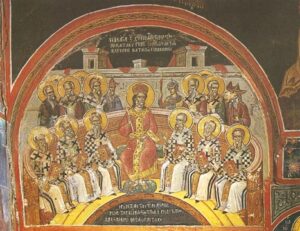
In the year 783 the Seventh Ecumenical Council declared that images not only may but must be used in Church – we’ll recite part of their decree at the end of the procession in church on Sunday – as a witness to Christ’s Incarnation. And also we venerate icons of his saints for the Church is Christ’s Body, the extension of His Incarnation. Indeed, all the people of God are Christ’s visible presence on earth.
And that brings us back to the Gospel for the First Sunday of Lent: Who is Jesus? He is God the Word truly made flesh. We have seen “the glory of God in the face of Jesus Christ”. Jesus said “To see Me is to see the Father.”
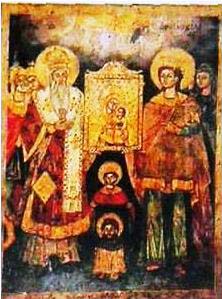
The Seventh Council had condemned iconoclasm – but still the conflict went on for another sixty years till Empress Theodora came to the throne. On March 11, 847, the First Sunday of Lent, she and Patriarch Methodios carried the holy icons in procession into the great church Aghia Sophia in Constantinople, thus restoring them once and for all to the Church. And ever since that day, in our churches and in our homes, our icons witness to the truth that Christ is God made Man.
(Much later, some radical ProtestanT iconoclasts smashed and burned images in churches.)
4 One thing more: Icons witness to our Orthodox understanding of the Church. The Church is not primarily an institution, but rather a family, a fellowship of people who are brothers and sisters in Jesus Christ, a community of love transcending Heaven and earth. And therefore Philip’s invitation to Nathanael still stands today: Come and see!
The Triumph of Orthodoxy
This Sunday is sometimes called the Sunday of the Triumph of Orthodoxy. Because we Orthodox rule the world? Well, not exactly! Nor should we expect to: Jesus said His kingdom is not of this world. What is triumphant is the Orthodox Faith. That is what endures.
Read history: False teachings, heresies, schisms, enemies come and go – the Roman Empire, Crusaders and Mongols and Turks and Communists. They all had their day and are gone.
In my lifetime Orthodoxy in Russia emerged unscathed after decades of Communist persecution – and it will survive their present Patriarch. (Kyrill is not the only Orthodox Patriarch who ever sold out.) Likewise here in the West, today’s denominations will eventually return to Orthodox Faith, or they will fail. Throughout history they always have. They have no lasting power. You can see that from the way they forever reshape and reassemble themselves. Likewise today’s secularism, both of the left and of the right, will pass. That is the lesson of history.
Here is another lesson of history: The Holy Orthodox Faith in the Holy Orthodox Church just keeps going on and on and on We celebrate the Restoration of the Holy Icons because that – 1200 years ago – was the last theological controversy in the Orthodox Church. * Even the Iconoclastic Controversy was a manufactured issue: If it hadn’t been for a few nasty emperors, it would have quickly come to nothing.
- Well, there was a little kerfuffle back in the 1300s, but it quickly faded away.
Here’s the point: The issues that today are tearing apart the various denominations and societies affect us Orthodox almost not at all. Does anything ever change here? Yes but, as Father Alexander Schmemann put it, “The Orthodox Church changes only in order to remain the same”! The Orthodox Church changes very slowly and deliberately, guarded by and never departing from “the Faith which was once delivered to the saints”. Jude 1:3
To put it negatively, if you’re looking for a church which swings right and left, back and forth with the winds of the times, you’ve come to the wrong place!
Orthodox people may argue about this and that – what color to paint the ceiling, or which desert to make. We sinners can usually find some little thing to fuss about. But we do not argue about the Faith. In every Orthodox Church from one end of the world to the other, the same Apostolic Faith is proclaimed with nothing added, nothing subtracted. That is why, in every Orthodox church from one end of the world to another, this First Sunday of Lent we all will have processions to celebrate the Restoration of the Holy Icons.

Above you see the Orthodox Ship sailing unperturbed past all the heresies and threats of the world. What this image does not show is the squabbling that sometimes occurs on board! – which at the moment is much worse than usual. Despite that the Ship always stays steady. That is clear evidence that Orthodoxy triumphs through no virtue or power of ours – God knows – but by His grace, by the power of His Holy Spirit.
This is what our Lord prayed for His Church: “that they all may be one, as You, Father, are in Me, and I in You; that they also may be one in Us, that the world may believe that You sent Me.” John 17:21 This is the Triumph of Orthodoxy. “This is the Faith of the Apostles, this is the Faith of the Fathers, this is the Faith of the Orthodox, this is the Faith which has established the Universe.”
This Sunday as we march around our churches, we are not just carrying our icons into Hagia Sophia twelve centuries ago. We are carrying the Orthodox Faith, undefiled, triumphant, on into the 21st Century.
Next Week: The Forty Holy Martyrs
Week after next: Advice about Fasting from the Fathers